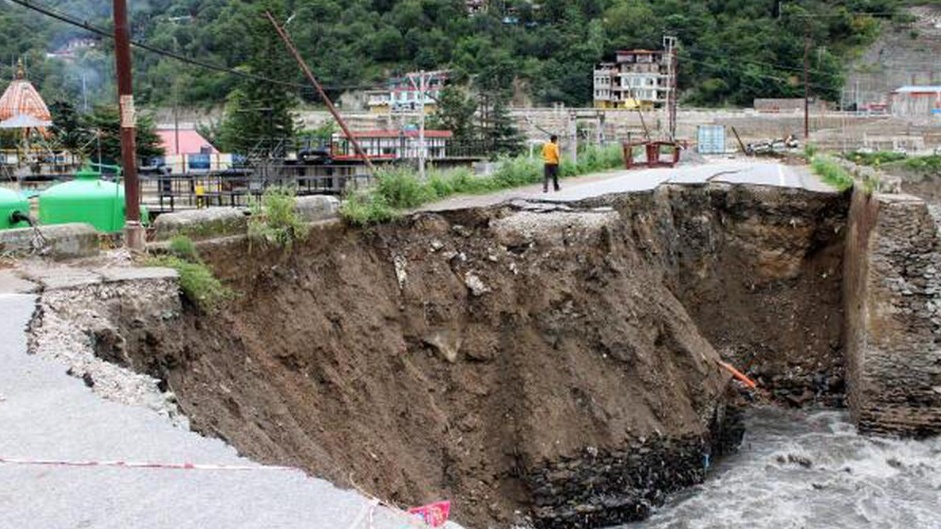Cloudbursts in Himachal Pradesh (GS Paper 1, Disaster Management)

Why in News?
- Recent cloudbursts in Himachal Pradesh have caused significant devastation, highlighting the urgent need to understand, predict, and mitigate the impacts of such extreme weather events.
- This article delves into what cloudbursts are, their causes and consequences, and effective strategies for disaster management.
Introduction
- Himachal Pradesh has recently experienced severe cloudbursts that resulted in flash floods, leading to loss of lives and extensive damage to infrastructure.
- These sudden and intense weather phenomena are increasingly becoming a concern due to their unpredictable nature and significant impact on mountainous regions.
- Understanding the characteristics of cloudbursts, their causes, and effective mitigation strategies is crucial for better disaster management and response.
What is a Cloudburst?
Definition and Characteristics
- According to the India Meteorological Department (IMD), a cloudburst is a sudden, intense rainstorm where more than 10 cm of rain falls in less than an hour over a relatively small area (about 10 square kilometers).
- Typically occurring in mountainous regions, such as the Himalayas, cloudbursts can lead to severe flash floods and landslides.
Causes
- Cloudbursts are caused by strong upward air currents that prevent raindrops from falling until they grow too large.
- When these currents weaken, the accumulated water is released abruptly, causing intense rainfall.
- The mountainous topography of the Indian subcontinent, particularly in the Himalayas, facilitates this phenomenon through orographic lifting, where moist air ascends over mountains, enhancing cloud formation and precipitation.
Prediction Challenges
- Predicting cloudbursts is challenging due to their localized and sudden nature.
- Current satellite and ground-based monitoring systems are inadequate for forecasting these events accurately.
- Effective prediction would require a dense network of radars and sophisticated technology, which is currently costly and complex.
Examples of Cloudbursts
- Uttarakhand Cloudburst (July 2021): This event caused flash floods, landslides, and significant damage to infrastructure in Chamoli, Uttarkashi, and Pithoragarh.
- Himachal Pradesh Cloudburst (August 2020): Cloudbursts in Kullu, Lahaul-Spiti, and Kinnaur triggered landslides and flash floods, impacting roads, bridges, and homes.
Consequences of Cloudbursts
Flash Floods
- Flash floods are rapid surges in water levels during or after intense rainfall, typically starting within 3-6 hours.
- They can be triggered by thunderstorms, dam breaches, or mudslides, and their severity is influenced by factors such as rainfall intensity, land use, topography, and soil type.
Landslides
- Landslides involve the downward movement of rock, earth, or debris and can be triggered by heavy rainfall, erosion, and weathering.
- In India, landslides account for around 8% of global fatalities, with significant risk in areas like Sikkim and Kerala.
Mudflows
- Mudflows are dense, viscous flows containing suspended particles and silt.
- They can transport and deposit coarser materials, leading to sediment accumulation and affecting downstream areas less than regular water streams.
Impact of Climate Change on Cloudbursts
Increased Atmospheric Moisture
- Rising temperatures enable the atmosphere to hold more moisture, which can lead to more intense cloud formation and a higher likelihood of cloudbursts.
Changes in Precipitation Patterns
- Climate change can alter precipitation patterns, causing regions to experience more extreme rainfall events or prolonged dry spells, contributing to the frequency of cloudbursts.
Altered Atmospheric Stability
- Higher temperatures can destabilize the atmosphere, increasing convective activity and the likelihood of thunderstorms associated with cloudbursts.
Glacier Retreat and Snowmelt
- Melting glaciers, particularly in the Himalayas, release water more rapidly, potentially exacerbating cloudburst events.
Land Use Changes
- Deforestation and urbanization can alter local climates and precipitation patterns, influencing the occurrence of cloudbursts.
Mitigation Strategies for Cloudbursts
Early Warning Systems
- Developing advanced early warning systems to predict cloudbursts and provide timely alerts can help in evacuation and preparedness, reducing the impact on communities.
Urban Planning and Infrastructure
- Investing in resilient infrastructure, such as stormwater drainage systems and retention ponds, can manage excess water and mitigate flooding.
Watershed Management
- Effective watershed management practices, like reducing soil erosion and increasing soil infiltration, can help control water flow and reduce the impact of cloudbursts.
Reforestation and Green Infrastructure
- Planting trees and maintaining green spaces can absorb excess water, reduce soil erosion, and stabilize slopes, mitigating cloudburst effects.
Awareness and Education
- Educating communities about cloudburst risks and training them on response and evacuation procedures can enhance preparedness and resilience.
Sustainable Land Use Practices
- Promoting land use practices that avoid construction in flood-prone areas, controlling deforestation, and implementing soil conservation measures can reduce vulnerability to cloudbursts.
International Cooperation
- Collaborating with neighboring countries and international organizations to share best practices, technology, and resources can improve cloudburst management, especially in shared river basins.
Conclusion
- The recent cloudbursts in Himachal Pradesh underscore the need for enhanced understanding and management of these extreme weather events.
- By investing in prediction technology, improving infrastructure, and fostering community preparedness, the impact of cloudbursts can be mitigated.
- Addressing the challenges posed by climate change and adopting sustainable practices are essential steps toward building resilience against these devastating phenomena.


